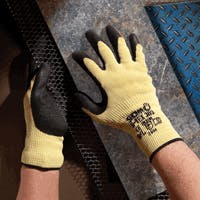Like many, the construction industry is asking employees to do more with less. Contractors, in particular, are trying to address safety concerns in the face of a difficult economy and increased government enforcement.
Most reputable firms promote safety as a core value, but some find holding true to that value in a down economy can be a challenge. Risk management and safety professionals are focused on how to maintain safety in a business environment where workers are expected to do more with less. According to a report by McGraw Hill Construction, in many cases, contractors may be using fewer laborers or tradespeople to complete tasks than in the past, and it is not uncommon for construction companies to ask themselves questions like “How many laborers do we need to move material from one spot to another?” and “Can we get by with less and still be safe?”
As basic as that last question seems, there is a surprisingly simply answer and proven fact when it comes to hand safety: Wearing the right glove for the task can improve safety and reduce injury.
According to the National Safety Council, there are 3.4 billion work-related injuries annually with $156.2 billion spent each year on work-related injuries. Slices, cuts and abrasions account for almost 30 percent of the lost time and productivity in the United States and almost 80 percent of these incidents involve the hands.
Specifically for the construction industry, the National Safety Council’s Injury Facts 2010 uses 2007 data and lists 12,530 injuries to the fingers, 7,490 to hand excluding fingers and 3,770 injuries to the wrist. It bears repeating: Finger and hand injuries were the most often injured body part among construction workers, accounting for one-third of emergency room visits, based on findings from a 7-year study of nonfatal injuries of construction workers at the George Washington University Emergency Department.
Construction Hand Hazards
Common hazards on a construction site fall into four main categories: chemical, mechanical, thermal and electrical. Add in high employee turnover, a constantly changing environment and different types of work being performed, and you can see that selecting the right personal protection equipment (PPE) for the hazards encountered and the task undertaken is an important job. Today’s gloves are designed to protect workers from everything from the threat of lacerations from the rough and sharp edges of building materials such as glass, brick and roofing; to the potentially poisonous effect of hexavalent chromium in Portland cement; to chemical skin burns. Gloves protect hands from the many materials and tools handled in the course of a day’s work.
Gloves designed for cut-resistance and oil-absorbance are an excellent choice to reduce injuries from cuts and/or dropping parts and are ideal for handling sheet metal or other materials that present multiple hazards. Protecting from lacerations while providing enhanced gripping action serves a dual purpose that mutually is beneficial to both the worker and the employer. High performance polyethylene fibers can be made even stronger by wrapping with stainless steel or fiberglass yarn for the highest cut resistance available. Certain coatings offer the advantage of adding high durability to cut-resistant liners that could be worn out quickly in handling concrete blocks or bricks.
Knowing what glove is right for the hazard and task and then developing a hand protection program as a part of an overall safety and risk management program can help companies mitigate risk and reduce injuries and injury-related absenteeism.
Better Glove Options
Chemical resistance: Chemical-resistant gloves are fully coated with a chemical-resistant polymer coating such as Nitrile, Neoprene or PVC. Recent developments in glove manufacturing have made wearing gloves that protect against chemicals such as hexavalent chromium more attractive and these materials offer excellent protection from caustic and poisonous hexavalent chromium in wet cement. Workers find the flat-dipped, lightly coated gloves comfortable and attractive because of their dexterity, which cuts down on hand fatigue. Today’s lighter-weight gloves encourage continual wear by the worker and wear for a broad range of uses.Oily grip: Foam or sponge Nitrile gloves are used in the industry because they feature a porous polymer coating that has the ability to grip an oily, slippery object, helping workers avoid dropping objects that could cause injury to the hands or other body parts. Some multi-functional gloves offer the benefits of the powerful gripping action of sponge Nitrile coatings plus high visibility liners that enhance safety in construction applications where high visibility is essential to worker safety.
Cut resistance: Gloves that offer sponge Nitrile coatings with a liner of cut-resistant yarns offer both oily grip and cut resistance. These gloves are ideal for handling sheet metal or other materials that present multiple hazards. Cut resistance normally is measured using a blade that is similar to a razor blade. Of course, there is no cut-resistant glove that works for moving or serrated blades. Moving blades will cut through a cut-resistant glove and should be avoided using engineering controls. Serrated blades can get caught in the knit material used in cut-resistant gloves and cut through them.
Continuous wear: Although lighter, coated, thinner knit gloves are not as cut resistant as heavier, thicker gloves, they more easily are worn for a variety of tasks where workers previously may have shed gloves to gain the touch sensitivity and dexterity needed to perform a task.
Durability: Durability or length of wear of polymeric materials can be two to 10 times longer for gloves that are coated compared to leather and cotton gloves. Some flat-dipped gloves even have an extra layer of polymer in the areas of the glove that wear the most, such as the thumb crotch between the thumb and first finger. Today’s PPE glove market features new technologies that are providing high levels of cut resistance and more flexible, longer-lasting gloves. Hi-vis colors, illuminated backs, ventilated backs, task-specific levels of coatings and specific sizing are making gloves more resilient and serviceable for more applications than traditional work gloves. They also have far superior barrier properties and longer lasting coatings. Even in a down economy where construction workers are being asked to do more with less, everyone has a right to be safe at work and to return home the same as when they started the day. It could be as easy as putting on a glove.
Donald F. Groce is a technical product specialist and a research chemist for Showa Best Glove. Before joining Showa Best Glove, he worked for the U.S. Centers for Disease Control and Prevention on chemical toxicology studies that included the Agent Orange study. He is a noted speaker and expert on a variety of occupational and workplace hazards, including latex allergies and chemical exposure-related illnesses. He is a part of the local Citizen’s Meth Task Force and serves on the NFPA 1999 Technical Committee and the American Industrial Hygiene Protective Clothing Committee.
